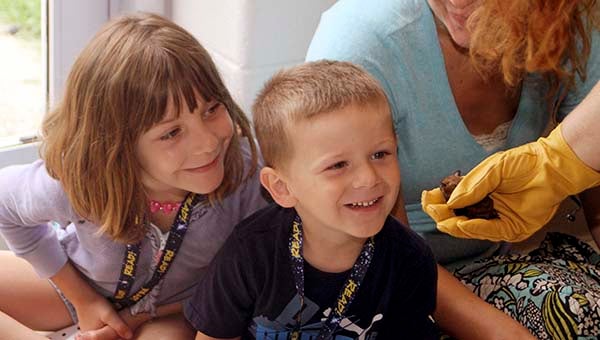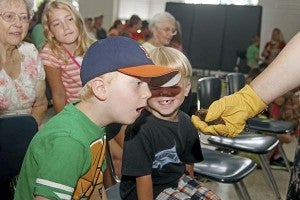Children charmed by bats
Published 10:20 am Wednesday, July 23, 2014

Raina Smith and her brother Buzz get a look at Bella the big brown bat at Windsor High School on Tuesday. The bats were at the school as part of the Windsor Branch’s Summer Reading Program. — Cain Madden | Tidewater News
WINDSOR—Being obsessed with all things flight, going to the Windsor Library’s Summer Reading program on Tuesday was a no-brainer.

Ethan Jones, 6, of Windsor, looks on in amazement of Bella, a big brown bat. Beside him is Cole Mumford, 5, of Suffolk. — CAIN MADDEN | TIDEWATER NEWS
Normally, 7-year-old Raina Smith is more into daytime flyers such as birds, particularly the hummingbirds that visit her yard. On Tuesday, however, the Ivor girl came face-to-face with a fellow mammal that flies.
“I did not expect they would be so cute,” said Smith, who had never seen a bat up close. “They are so tiny and cute.”
When Emily Kontz, 10, saw Shu, the fruit bat, she wanted one.
“I liked them,” the Windsor girl said. “I liked that the fruit bat got to stick its tongue out. It looked like a little fox.”
Before she left, Kontz talked to Denise Tomlinson, the biologist who displayed the bats, about what she did.
When asked if she wanted to be a biologist when she grew up, Kontz said, “Sounds good! I love animals.”
Tomlinson, of Bat World Hampton Roads, was on hand with a story time on the children’s book “Stellaluna.” The book is about a small African fruit bat named Stellaluna, who, attacked by an owl, was separated from her mother and was raised by birds.
Once the story was over, Tomlinson talked about the differences between bats and birds, and then she gave some details on bats.
“One bat can eat 600 mosquito-sized insects in an hour,” she said. “Bats are eating their entire body weight for dinner each night. That’s the equivalent of kids having to eat 10 to 25 full size-large pizzas in a night.”
Bats also eat bugs such as spiders, and some even eat fruit, fish and birds.
Due to the decreasing size of the forests, where bats prefer to live, Tomlinson also talked about building or buying bat houses. The bat houses are relatively thin rectangular boxes that hang facing down, where the holes that the bats enter are. In a relatively small box, Tomlinson said 300 bats could make a nest.
While it may be natural to think that you should put the house up in the woods near the shade, bats actually would prefer a place that gets direct sunlight. In the wild, Bats prefer dead trees with no leaves to block the sun.
“Think about where they go when they get in your house,” she said. “They go up in the attic. Bats like it warm.”
One benefit to having a bat house, Tomlinson said, is that if you have 300 bats lurking around your property, they are eating more than 1 million mosquitoes each night.
Erinn Smith, Raina’s mother, said she had been thinking about getting a bat house, and did ask Tomlinson about them afterward. Her son, Buzz, was excited about getting new bat roommates.
“I love them,” he said. “I hope we make one big enough that we can get every bat in the world to come.”
His sister was also excited.
“I can’t wait to stand under it and look up and see the bats sleeping,” Raina said.
Once Tomlinson talked about the bat house, she showed off Bella, a big brown bat, which is a Virginia native, and Shu, an Egyptian fruit bat, named after the Egyptian God.
“I liked both of them,” said Hannah Elley, 5. “It was really hard to see the little one’s eyes, but the big one had big cute eyes.”
Bella wasn’t without her fans.
“She was cute,” Kontz said. “She had a little baby face.”
Tomlinson also wanted to let the kids know that Wednesday, July 23, was going to be a special Bat day.
“It’s Batman’s 75th anniversary,” she said, asking how many knew that and a couple older boys raised their hands.
Wearing a Batman anniversary pin on her lanyard, Branch Manager Bonnie Lauver said the event had gone well, as has the Summer Reading Program as a whole in the community.
“We had 109 children for this,” she said. “I think the children really enjoyed it. It is nice to be able to introduce them to things that they do not normally see.”
And many of them did verbalize that it was good to see something they didn’t normally see, including Raina.
“I think they are so cool,” she said. “I like how cute they are and that they can fly. I also like how they cling onto things.”





